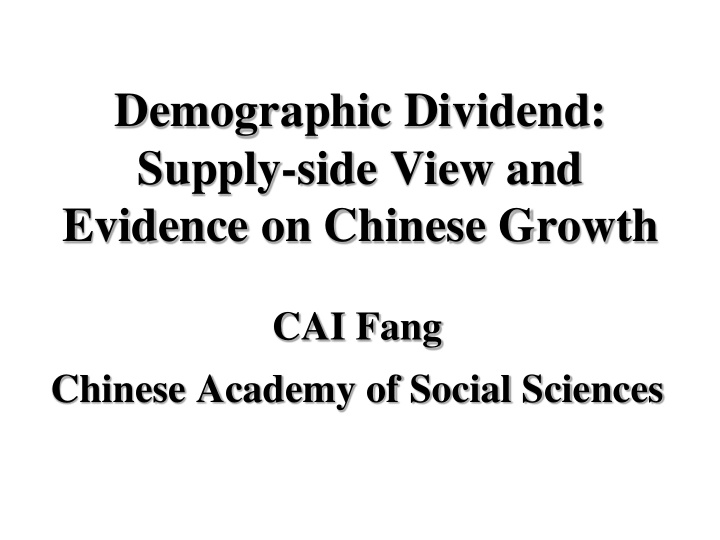



Demographic Dividend: Supply-side View and Evidence on Chinese Growth CAI Fang Chinese Academy of Social Sciences
1. Fast Growth alongside Rapid Demographic Transition
Very Low Fertility for Many Years (and two features) 8 N at i onal U r ban R ur al 7 6 TFR 5 4 3 2 1 0 1950 1953 1956 1959 1962 1965 1968 1971 1974 1977 1980 1983 1986 1989 1992 1995 1998 2001 2004 2007
Age Structure Changes Faster (WAP rise & dependence decline) 2000 2010 80+ 80+ 70- 74 70- 74 60- 64 60- 64 50- 54 50- 54 40- 44 40- 44 30- 34 30- 34 20- 24 20- 24 10- 14 10- 14 0- 4 0- 4 12 10 8 6 4 2 0 2 4 6 8 10 12 12 10 8 6 4 2 0 2 4 6 8 10 12 P R C Less devel oped r egi ons P R C Less devel oped r egi ons
Decomposing China’s Growth (preventing diminishing return on K ) E ducat i on 6% Labor R eal l ocat i on 9% 8% TFP 24% R esi dual 16% C api t al 61%
G D P gr ow t h r at e ( % ) 10 12 14 16 0 2 4 6 8 High Potential + Strong Demand 1979 1980 1981 1982 1983 = Fast Actual Growth 1984 1985 1986 1987 1988 1989 1990 1991 1992 1993 Act ual 1994 1995 1996 1997 1998 1999 Pot ent i al 2000 2001 2002 2003 2004 2005 Aver age 2006 2007 2008 2009 2010
2. Disappearance of Demographic Dividend
Reversed Demographic Factors (WAP shrinks & dependence rises) 100000 100 Working age 90000 90 population Working age population (10 thousand) 80000 80 Dependence ratio (%) 70000 70 60000 60 Dependence ratio 50000 50 40000 40 30000 30 20000 20 10000 10 0 0 2010 2012 2014 2016 2018 2020 2022 2024 2026 2028 2030 2032 2034 2036 2038 2040 2042 2044 2046 2048 2050
As Result, One, Return on K Decreases, Estimated by Various Studies 0. 45 G uo B ai M P K ( 变) M P K ( 0. 55) G ong 0. 40 0. 35 0. 30 0. 25 0. 20 0. 15 0. 10 1971 1973 1975 1977 1979 1981 1983 1985 1987 1989 1991 1993 1995 1997 1999 2001 2003 2005 2007 2009
Two, L Becomes Scarce and Wage of Unskilled Workers Increase 2500 80 70 2000 60 Monthly wages (yuan) Daily wages (yuan) 50 1500 40 1000 30 20 500 10 0 0 2001 2002 2003 2004 2005 2006 2007 2008 2009 2010 2011 2012 M i gr ant s M anuf act ur i ng C onst r uct i on Years G r ai ns C ot t on Pi g f ar m
Three, Room for Reallocation Efficiency (TFP) Becomes Smaller 900 800 i l . ) 700 Labor f or ce ( m 600 500 N on- agr i cul t ur al 400 300 200 Agr i cul t ur al 100 0 1984 1985 1986 1987 1988 1989 1990 1991 1992 1993 1994 1995 1996 1997 1998 1999 2000 2001 2002 2003 2004 2005 2006 2007 2008 2009 2010 2011 2012
Finally, Potential Growth Rate Slows Down and Slowdown Will Continue 14 Per i od Annual ) t h r at e ( % 12 10. 3 10 Annual pot ent i al gr ow 7. 6 8 6. 2 6 4 2 0 1995 1996 1997 1998 1999 2000 2001 2002 2003 2004 2005 2006 2007 2008 2009 2010 2011 2012 2013 2014 2015 2016 2017 2018 2019 2020
3. From Demographic Dividend To Reform Dividend
Since It Is Supply-side Factors Cause Slowdown, PGR Can Be Increased 4. 6 par at i ve advant age i ndex 4. 4 4. 2 4. 0 3. 8 3. 6 eveal ed com 3. 4 3. 2 R 3. 0 2003 2004 2005 2006 2007 2008 2009 2010 2011 2012 2013
By Reforms to Increase Labor Supply, Human Capital, TFP, & Hopefully TFR 60 H avi ng urban resi dence Li vi ng i n ci t i es 50 opul ati on share (% ) 40 30 20 P 10 0 1990 1991 1992 1993 1995 1996 1997 1998 2000 2001 2002 2003 2005 2006 2007 2008 2010 2011 2012 1994 1999 2004 2009
Future Scenarios of Potential Growth Rates under Dif. Assumptions 10 Basel i ne Scenar i o A Scenar i o B Scenar i o C 9 t h r at e ( % ) 8 7 ot ent i al gr ow 6 5 P 4 3 2011 2013 2015 2017 2019 2021 2023 2025 2027 2029 2031 2033 2035 2037 2039 2041 2043 2045 2047 2049 Y ear s
Thank You!
Recommend
More recommend